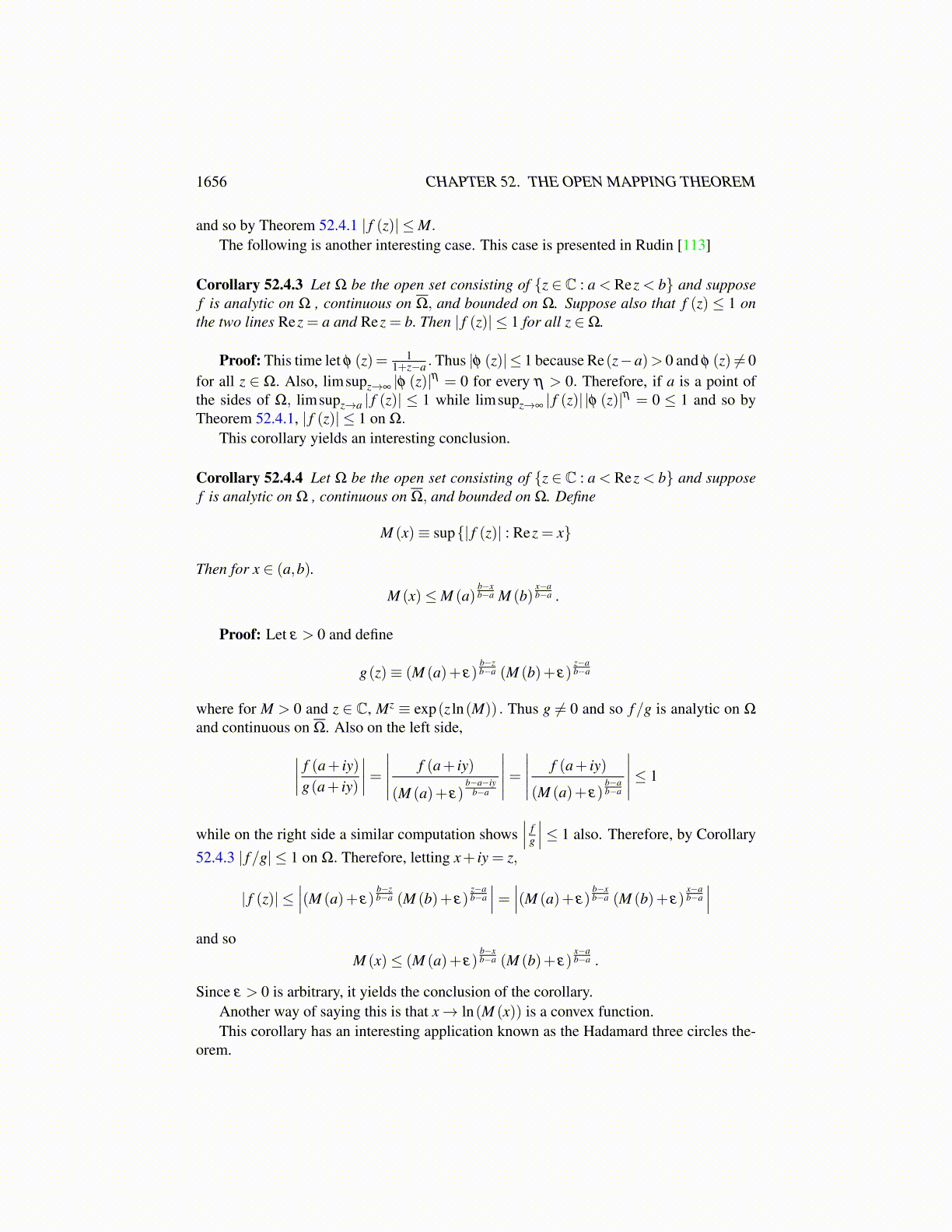
1656 CHAPTER 52. THE OPEN MAPPING THEOREM
Note that if limsupz→a | f (z)| ≤ M and δ > 0, then there exists r > 0 such that if z ∈B′ (a,r)∩S, then | f (z)|< M+δ . If a = ∞, there exists r > 0 such that if |z|> r and z ∈ S,then | f (z)|< M+δ .
Theorem 52.3.5 Let Ω be an open set in C and let f : Ω→ C be analytic. Suppose alsothat for every a ∈ ∂∞Ω,
limsupz→a| f (z)| ≤M < ∞.
Then in fact | f (z)| ≤M for all z ∈Ω.
Proof: Let δ > 0 and let H ≡ {z ∈Ω : | f (z)|> M+δ} . Suppose H ̸= /0. Then H isan open subset of Ω. I claim that H is actually bounded. If Ω is bounded, there is nothingto show so assume Ω is unbounded. Then the condition involving the limsup impliesthere exists r > 0 such that if |z| > r and z ∈ Ω, then | f (z)| ≤ M + δ/2. It follows H iscontained in B(0,r) and so it is bounded. Now consider the components of Ω. One ofthese components contains points from H. Let this component be denoted as V and letHV ≡ H ∩V. Thus HV is a bounded open subset of V. Let U be a component of HV . Firstsuppose U ⊆ V . In this case, it follows that on ∂U, | f (z)| = M + δ and so by Theorem52.3.1 | f (z)| ≤ M + δ for all z ∈ U contradicting the definition of H. Next suppose ∂Ucontains a point of ∂V,a. Then in this case, a violates the condition on limsup . Either wayyou get a contradiction. Hence H = /0 as claimed. Since δ > 0 is arbitrary, this shows| f (z)| ≤M.
52.4 Extensions Of Maximum Modulus Theorem52.4.1 Phragmên Lindelöf TheoremThis theorem is an extension of Theorem 52.3.5. It uses a growth condition near the ex-tended boundary to conclude that f is bounded. I will present the version found in Conway[32]. It seems to be more of a method than an actual theorem. There are several versionsof it.
Theorem 52.4.1 Let Ω be a simply connected region in C and suppose f is analytic onΩ. Also suppose there exists a function, φ which is nonzero and uniformly bounded onΩ. Let M be a positive number. Now suppose ∂∞Ω = A∪B such that for every a ∈ A,limsupz→a | f (z)| ≤M and for every b∈ B, and η > 0, limsupz→b | f (z)| |φ (z)|η ≤M. Then| f (z)| ≤M for all z ∈Ω.
Proof: By Theorem 52.2.1 there exists log(φ (z)) analytic on Ω. Now define g(z) ≡exp(η log(φ (z))) so that g(z) = φ (z)η . Now also
|g(z)|= |exp(η log(φ (z)))|= |exp(η ln |φ (z)|)|= |φ (z)|η .
Let m ≥ |φ (z)| for all z ∈ Ω. Define F (z) ≡ f (z)g(z)m−η . Thus F is analytic and forb ∈ B,
limsupz→b|F (z)|= limsup
z→b| f (z)| |φ (z)|η m−η ≤Mm−η